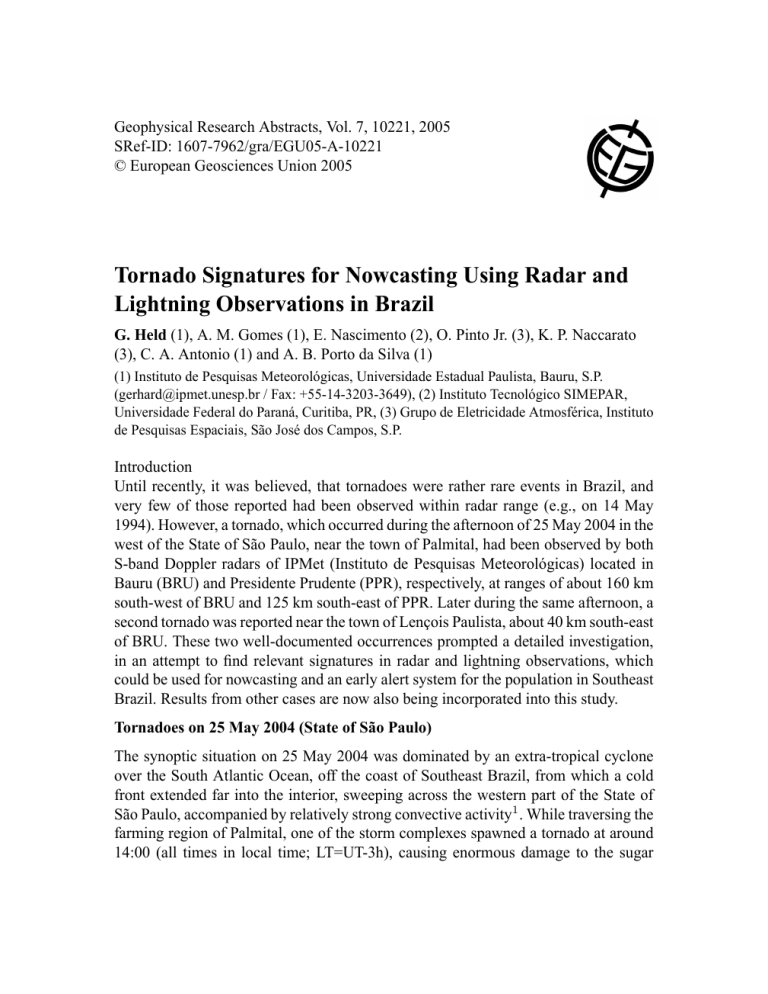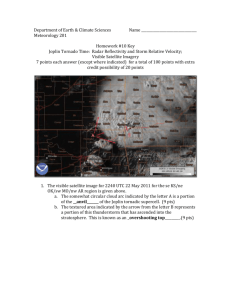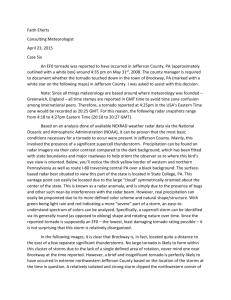Tornado Signatures for Nowcasting Using Radar and Lightning

Geophysical Research Abstracts, Vol. 7, 10221, 2005
SRef-ID: 1607-7962/gra/EGU05-A-10221
© European Geosciences Union 2005
Tornado Signatures for Nowcasting Using Radar and
Lightning Observations in Brazil
G. Held (1), A. M. Gomes (1), E. Nascimento (2), O. Pinto Jr. (3), K. P. Naccarato
(3), C. A. Antonio (1) and A. B. Porto da Silva (1)
(1) Instituto de Pesquisas Meteorológicas, Universidade Estadual Paulista, Bauru, S.P.
(gerhard@ipmet.unesp.br / Fax: +55-14-3203-3649), (2) Instituto Tecnológico SIMEPAR,
Universidade Federal do Paraná, Curitiba, PR, (3) Grupo de Eletricidade Atmosférica, Instituto de Pesquisas Espaciais, São José dos Campos, S.P.
Introduction
Until recently, it was believed, that tornadoes were rather rare events in Brazil, and very few of those reported had been observed within radar range (e.g., on 14 May
1994). However, a tornado, which occurred during the afternoon of 25 May 2004 in the west of the State of São Paulo, near the town of Palmital, had been observed by both
S-band Doppler radars of IPMet (Instituto de Pesquisas Meteorológicas) located in
Bauru (BRU) and Presidente Prudente (PPR), respectively, at ranges of about 160 km south-west of BRU and 125 km south-east of PPR. Later during the same afternoon, a second tornado was reported near the town of Lençois Paulista, about 40 km south-east of BRU. These two well-documented occurrences prompted a detailed investigation, in an attempt to find relevant signatures in radar and lightning observations, which could be used for nowcasting and an early alert system for the population in Southeast
Brazil. Results from other cases are now also being incorporated into this study.
Tornadoes on 25 May 2004 (State of São Paulo)
The synoptic situation on 25 May 2004 was dominated by an extra-tropical cyclone over the South Atlantic Ocean, off the coast of Southeast Brazil, from which a cold front extended far into the interior, sweeping across the western part of the State of
São Paulo, accompanied by relatively strong convective activity 1 . While traversing the farming region of Palmital, one of the storm complexes spawned a tornado at around
14:00 (all times in local time; LT=UT-3h), causing enormous damage to the sugar
plantations and overturning a large stationary bus, filled with 53 agricultural workers, along its longitudinal axis, leaving it on its roof about 30 m from its original position
(F2-F3 damage). Two passengers were killed and many others injured. According to eyewitnesses, the event was preceded by a roaring noise, similar to a jet engine.
The destruction path was up to 100 m wide and extended for approximately 15 km towards east-south-east. The second tornado, which occurred at around 17:00 about
140 km east of the first one, only caused significant damage to sugar plantations along its 100m wide and 8 km long path, but fortunately no harm was done to persons (F2 damage).
The radar observations from PPR
1 showed the development of a “hook echo”, typical for supercell storms in their tornadic stage, at 13:23. The storm moved in an eastsouth-easterly direction at about 55 km.h
− 1 . The radial velocities near ground level showed the formation of a “velocity couplet” with speeds ranging from about –28 to
+9 m.s
− 1 , inducing a local shear reaching –5,2x10
− 3 s
− 1 at 13:46 and 13:53, indicating the presence of a low-level mesocyclone, typical of tornadic supercells. It is noteworthy, that an even more intense storm, in terms of radar reflectivity, with a wellformed ‘Weak Echo Region’ at its leading edge, was observed almost 60 km to the north and moving in parallel to the tornadic cell. However, there was no confirmed tornado touch-down, due to a lack of observations by eyewitnesses. Nevertheless, due to its longevity after first detection at 10:00, as well maintaining radar reflectivities between 50 and 60 dBZ during its four-hour mature lifetime, with radial velocities of up to 35m.s
− 1
, indicating a strong updraft and cyclonic rotational forces between 4 and 9km height, it is classified as a supercell storm
1
.
A comparison of lightning records with radar observations indicates, that the frequency of ground strikes from the first tornado cell was significantly higher before the tornado touched down. The first ground strikes were observed at the time the hook echo developed (13:23), gradually increasing in frequency from 1-2 per km 2 over a
15x15 km area (7,5 min time intervals, corresponding to the radar volume scans), with almost all flashes being ahead of the cell core, until 13:46. Thereafter, the frequency dropped off, but flashes appear to be grouped around the updraft center, and not within the cell core (tornado funnel ?) from 14:01 to 14:16. From 14:23 onwards, only isolated flashes were recorded, which is in agreement with eyewitness reports, stating that it became very dark when the tornado touched down. In contrast, the cell to the north showed a slightly different behavior in flash rates and distribution, producing ≤ 7 flashes per km 2 within the volume scan intervals of 7,5 min from 13:38 onwards until
15:23, when up to 9 flashes per km 2 were recorded, all more or less equally distributed within the cell core 1 .
A second tornado was observed at around 17:00 near the town of Lençois Paulista, be-
ing spawned from a storm which had initially developed at 15:00 about 105 km westnorth-west of the BAU radar, moving south-eastwards across the radar at speeds of 55
– 65 km.h
− 1
. The storm was embedded within an unusually strong air flow from the north-west, resulting in up to three times folding of radial velocities (Nyquist velocity
16,5 m.s
− 1 ) . Reflectivity and radial velocity fields observed by the BAU radar indicate a strongly sheared storm environment, both horizontally and in the vertical, confirmed by vertical cross-sections, which show a Bounded Weak Echo Region (BWER) on the south-western flank towards the rear of the storm between 17:00 and 17:30. This would indicate a persistent strong updraft almost perpendicular to the general flow.
Echo tops (10 dBZ) initially reached up to 11 - 12 km, but decreased to about 10 km during the tornadic stage, increasing again to 11,2 km from 17:23 onwards. Throughout its life time, the maximum reflectivity was between 55 and 60 dBZ. It is noteworthy, that the echo tops of the storms surrounding the isolated tornadic cell reached up to 17 km. This difference in structure could be attributable to the vigorous updrafts and vertical shear during the formation of the tornado.
At 17:00 its echo core (60 dBZ at ± 1.7 km) was situated 15 km south-east of the radar.
The radial velocity field showed a maximum of +44 m.s
− 1 just above the reflectivity maximum, with a clear indication of cyclonic rotation on the 11º elevation PPI with a local shear of –3,0 x10
− 2 s
− 1 at around 2 km. As the storm continued along its track, the rotational signature intensified to reach a maximum of –5,0 x10
− 2 s
− 1 at
17:16 between 2 and 4 km and began to decrease in intensity and descend from 17:23 onwards.
As in the earlier case, intensive lightning activity was observed until 17:00, before the tornado touch-down, when no CG flashes were recorded from this cell until 17:30, with the exception of the volume scan from 17:16 – 17-22 (6 strokes). At the same time, ≥ 70 CG strokes per 7,5 min interval were recorded from the neighbouring storm complex.
Historic Tornado on 14 May 1994 (State of São Paulo)
The very first time a tornado signature was identified within the range of the Bauru radar occurred on 14 May 1994, when a large storm complex was moving southwards along an unusual north - south trajectory at an average speed of 62 km.h
− 1
(
2
) . A frontal system extending from an Atlantic Ocean Low across the southern States of
Brazil and an associated cut-off low over the State of São Paulo induced strong convergence at the surface, which triggered and maintained the storm. At least one cell of this long-lasting storm complex could be classified as a supercell storm, because radar reflectivities exceeding 60 dBZ were recorded for five hours. It caused extensive damage to property (US $ 11 million) and life, killing three people and injuring
130 (F1-F2 damage). When the reflectivities of this particular cell were analyzed in conjunction with the radial velocity fields, rotation signatures that could be related to the observed severity were identifyable. From this, as well as from the narrow path of destruction, it is thus assumed that the supercell had spawned a tornado. For most of its five-hour life cycle the maximum reflectivity exceeded 60 dBZ and echo tops (10 dBZ) varied between 10 and 13 km. Heavy bursts of hail were reported along its path.
The reflectivities and radial velocities of this storm clearly indicated an anticyclonic rotation, coincidental with the echo core (“couplet”). Considering that the storm was more than 150 km north-east of the radar, the rotation was evident between 0.3˚ and
1.7˚ elevation, corresponding to 4 – 6 km height, but most prominent at 4 km. It should be noted that in the south-eastern part of the rotation core radial velocities of up to +10 m.s
− 1 (outwards) were observed, while on the opposite side the radial velocities varied between –9 and –14 m.s
− 1
(towards the radar). The centers of velocity maxima were about 6 km apart, thus implying a local shear of –3.5x10
− 3 s
− 1
(
3
) . Such values are generally associated with mesocyclones or mesoanticyclones and are precursors for the formation of tornadoes
4
.
Tornado on 3 January 2005 (Santa Catarina State)
The most recent tornado episode in Brazil was reported in the city of Criciúma, in the southern portion of Santa Catarina State. Two tornadoes developed within a lapse of approximately 1-hr during the afternoon hours of 3 January 2005, with the first one causing F2 damage (Emerson Marcelino, personal communication). These were the most well documented Brazilian tornadoes ever, given the high quality photographs and footage taken from them. The nearest weather surveillance Doppler radar, from
Instituto Tecnológico SIMEPAR, is located more than 300 km north-north-west of
Criciúma. Unfortunately, no radial velocity scans are available at that range. Nevertheless, reflectivity fields from low-elevation surveillance PPIs (0.0 – 0.1º) at 10-min intervals from this radar allowed the detection of the explosive development of an isolated convective cell over Criciúma between 15:00 and 16:00 LT (summer time =
UT-2h). Maximum reflectivities exceeding 45 dBZ were recorded around 16:00 at a distance of 322 km from the radar (radar beam at approximately 6.7 km above ground level), observed with a 1.0º beam width. This implies the presence of a very intense
(estimated reflectivity > 60 dBZ) and massive echo core in order to fill the beam at this distance. In addition, the rapid convective development suggests the existence of very strong updrafts, which might have played some role for tornadogenesis given vortex stretching considerations. Around 80 houses were destroyed or badly damaged in the town of Criciúma and one person died along the tornado path.
The tornadic storm developed ahead (east) of a mid-latitude baroclinic wave, with a closed low pressure system at 850 hPa advancing over Paraguay and southern Brazil.
Mid-level flow from the northwest was present over southern Santa Catarina on that day, with a magnitude of around 15 m.s
− 1
. Just ahead of the low pressure center at
850 hPa, winds from the north transported moisture to southern Brazil, contributing to destabilize the atmosphere. At the surface, winds from the northeast were reported.
Thus, considerable directional wind shear in the vertical was already present a few hours before convective initiation, indicating a kinematic environment potentially favorable for mid-latitude-type severe thunderstorms, like supercells. Only a few isolated CG flashes were recorded by the Brazilian Lightning Detection Network, due to the currently inadequate coverage of southern Brazil. Thus, no conclusions can be drawn about the lightning activity of these tornadoes.
Conclusion
Until recently, tornadoes were believed to be rather rare and exceptional events in
Brazil, and very few observations had been available. However, during the southern hemisphere autumn in 2004, two confirmed tornadoes were observed in the State of
São Paulo by IPMet’s S-band Doppler radars. Simultaneous lightning stroke data were also available from the Brazilian National Lightning Detection Network. This allowed a detailed analysis of the three-dimensional structure of radar reflectivity and radial velocity fields of a tornadic cell and relate it to its lightning activity, with the ultimate goal to derive characteristic signatures which could aid the nowcaster to identify those and disseminate early warnings to the public. Similarily, two other occurrences of tornadoes, with less detailed information available, are also described.
The outstanding and common features suitable for nowcasting of tornadoes in Brazil were -
• Synoptic situations over South and Southeastern Brazil, favorable for the initiation of strong convection, usually indicated by unstable atmospheric conditions in a strongly sheared environment, but seasonally different;
• Formation of a supercell with strong rotational shear (observed magnitudes of
–5,2x10
− 3 s
− 1 to –5,0 x10
− 2 s
− 1 ) lasting at least 15 to 30 min;
• Such severe storms move extremely fast with speeds of > 50 km.h
− 1 twice as fast as the average speed of cells);
(about
• Intensive lightning activity of the cell prior to the tornado touch-down, dropping to very low stroke frequencies during the mature stage, after which it increased again.
This study highlights the importance of Doppler radar observations, especially as a useful tool for Nowcasting techniques, to predict the development of extremely severe
rain, hail or wind storms with the potential to cause destruction or even devastation.
However, the signatures described above need to be verified with more cases, before useful algorithms can be developed and implemented to issue automatic warnings for the forecaster.
References
Held G, AM Gomes, O Pinto JR, CAA Antonio and AB Porto da Silva. The Palmital Tornado: Lightning and Radar Observations. Proceedings, International Conference on Grounding and Earthing (GROUND’2004) & 1 st
International Conference on Lightning Physics and Effects, Belo Horizonte, MG, November 2004, 23-28.
1. Gomes AM, Held G, Lima MA e Calheiros RV. Estudo da evolução de tempestades severas na área central do estado de São Paulo por radar Doppler. Pro-
ceedings, XI Congresso Brasileiro de Meteorologia (CD ROM), SBMET, Rio de Janeiro, 16-20 de outubro de 2000, Paper MR00006, p 1921-1929.
2. Held G, Gomes AM and Nachtigall LF. Severe Storm Signatures Observed by
Doppler Radar in the State of São Paulo, Brazil: From Synoptic Scale to Microburst. Preprints, 30 th
International Conference on Radar Meteorology, Munich, Germany, 19-24 July 2001, 248-250.
3. Nielsen-Gammon, JW and Read EWL, 1995. Detection and interpretation of left-moving severe thunderstorms using the WSR-88D: A case study. Weather
and Forecasting, 10, 127-140.







